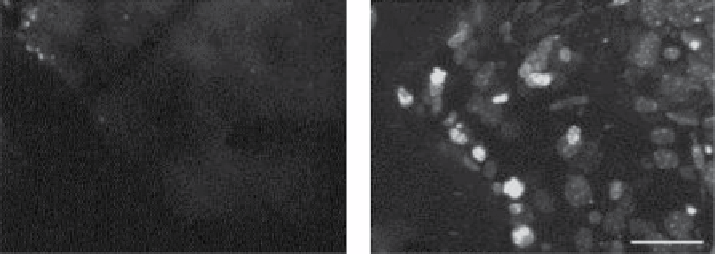Biomedical Engineering Reference
In-Depth Information
(a)
(b)
Hoechst alone
Hoechst NPs
figure 16.5
Hoechst alone does not cross the BBB (a), but PBCA NPs (coated with poly-
sorbate 80) inoculated with Hoechst dye will cross the BBB and stain the nuclei in the brain
(b). (Reprinted with permission from Ref. [31]. © National Academy of Sciences.)
[32]. Using bioluminescents, stem cell survival and follow-up studies of interactions
with the environment of the CNS can be evaluated in ways never before possible.
Using neural stem cells (NCS), which differentiate toward neurons, astrocytes, and
oligodendrocytes, and bone marrow-derived stromal cells (BMSC), which have
immune-modulating properties, studies have shown that they can monitor stem cell
survival rates, as well as their behavior with the CNS environment [32].
The ability to visualize neuronal injuries with a simple MRI down to a glial cell
level would drastically improve treatments and facilitate new modalities for imaging
the CNS. Manganese (Mn
+2
) can enter into neurons through voltage-gated calcium
channels, and from there, it can provide insight into the brain's physiology much
more precisely than other imaging agents such as gadolinium or iron oxide can [33].
16.5
comPAnion AnimAl diseAse models
The healthcare for companion animals follows as closely as possible to the current
state of human healthcare as allowed by the difference in economics. Pet dogs, cats
and other animals are generally well cared for and live considerably long lives. Many
of the diseases common in humans are represented in the companion animal
population as well, including cancer, diabetes, and neurologic injuries and disorders.
In many cases, the presentation and biology of these diseases is very similar to that of
human disease, much more so than induced or even genetically modified rodent
models. Pets with these ailments are often brought to veterinary specialists at regional
teaching hospitals for care. The presentation of pets with naturally occurring disease
negates the necessity of waiting for natural disease to occur in research animals.
Clinical trials with companion animals are thus relatively easy to arrange. Benefits
of companion animal clinical trials for preclinical trials are significant. In fact, the
NIH has initiated the Companion Animal Clinical Trials Consortium for the purpose
of aiding companies and researchers in the design, implementation, and analysis of
clinical trials through collaborations of institutions throughout the nation.

Search WWH ::

Custom Search